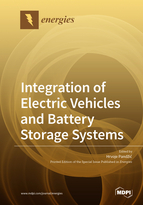Integration of Electric Vehicles and Battery Storage Systems
A special issue of Energies (ISSN 1996-1073). This special issue belongs to the section "F: Electrical Engineering".
Deadline for manuscript submissions: closed (20 October 2020) | Viewed by 29373
Special Issue Editor
Interests: power markets, smart grid, optimization and control
Special Issues, Collections and Topics in MDPI journals
Special Issue Information
Dear Colleagues,
Applications of batteries range from use in electric vehicles to large-scale installations, making them active and important elements in modern power systems. For this Special Issue of Energies, we invite authors to submit novel research on the integration of battery energy storage in power systems at all levels including their use in electric vehicles, stationary behind-the-meter, and independent installations. Relevant topics include system-wide applications of batteries, e.g. independent or aggregated bidding in energy and/or flexibility markets; locational services for system operators, e.g., congestion management, voltage support, or black start service; or services to network users, e.g., energy management in microgrids or energy communities. We are specifically interested in the following areas:
- Battery models that go beyond state-of-the-art technology;
- Market participation models for (distributed) batteries;
- Battery investment planning models;
- Models that include an electric vehicle and/or home user-behavior;
- Stacking of battery services to maximize profit;
- Voltage control models;
- Role of batteries at the distribution-level AC OPF;
- Batteries ensuring the N-1 criterion;
- Batteries used in industry facilities to provide demand management and retail arbitrage;
- New methods or applications of treating uncertainty.
Prof. Dr. Hrvoje Pandžić
Guest Editor
Manuscript Submission Information
Manuscripts should be submitted online at www.mdpi.com by registering and logging in to this website. Once you are registered, click here to go to the submission form. Manuscripts can be submitted until the deadline. All submissions that pass pre-check are peer-reviewed. Accepted papers will be published continuously in the journal (as soon as accepted) and will be listed together on the special issue website. Research articles, review articles as well as short communications are invited. For planned papers, a title and short abstract (about 100 words) can be sent to the Editorial Office for announcement on this website.
Submitted manuscripts should not have been published previously, nor be under consideration for publication elsewhere (except conference proceedings papers). All manuscripts are thoroughly refereed through a single-blind peer-review process. A guide for authors and other relevant information for submission of manuscripts is available on the Instructions for Authors page. Energies is an international peer-reviewed open access semimonthly journal published by MDPI.
Please visit the Instructions for Authors page before submitting a manuscript. The Article Processing Charge (APC) for publication in this open access journal is 2600 CHF (Swiss Francs). Submitted papers should be well formatted and use good English. Authors may use MDPI's English editing service prior to publication or during author revisions.
Keywords
- electric vehicles
- energy storage
- aggregation
- power system flexibility
- energy markets
- ancillary services






